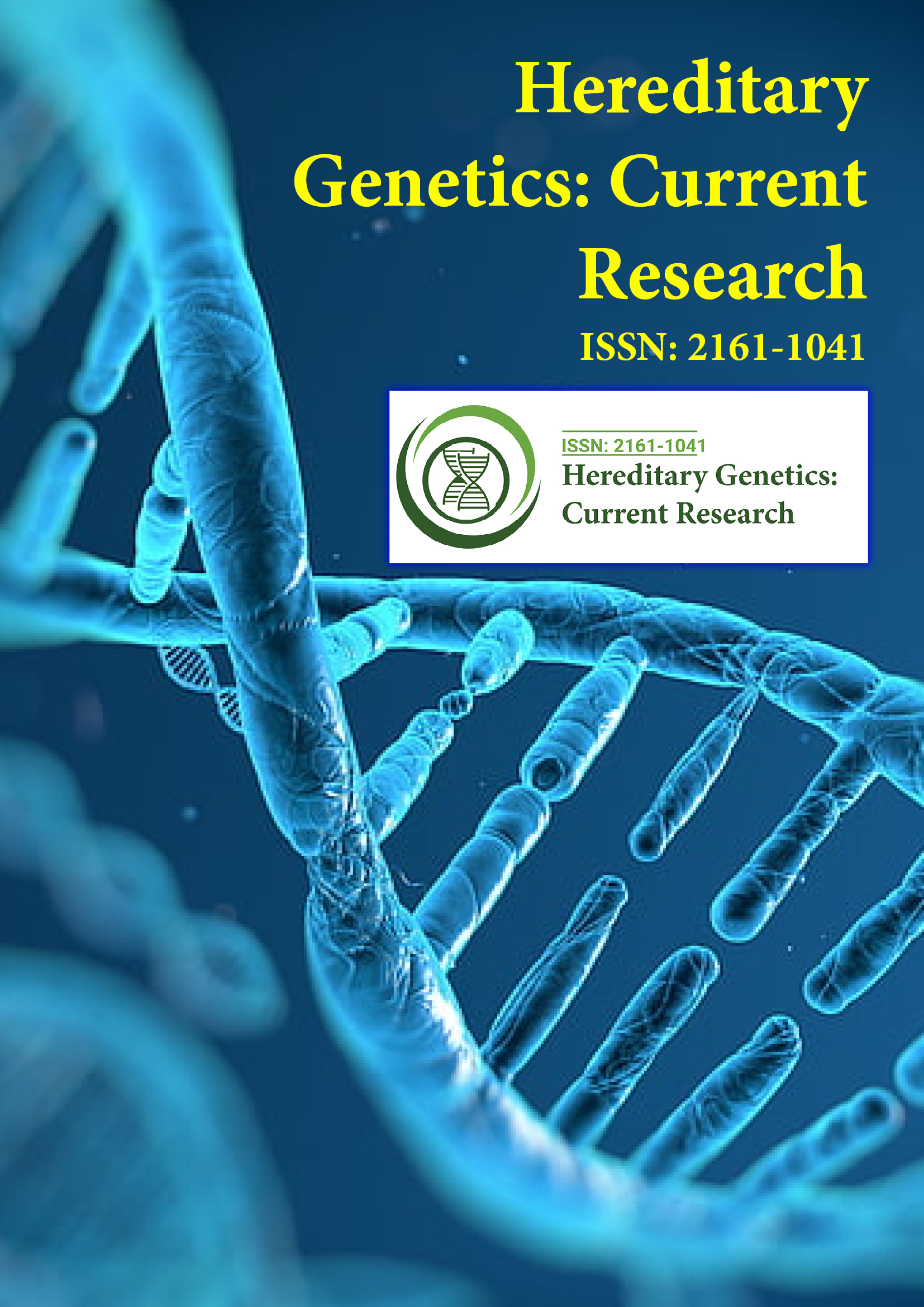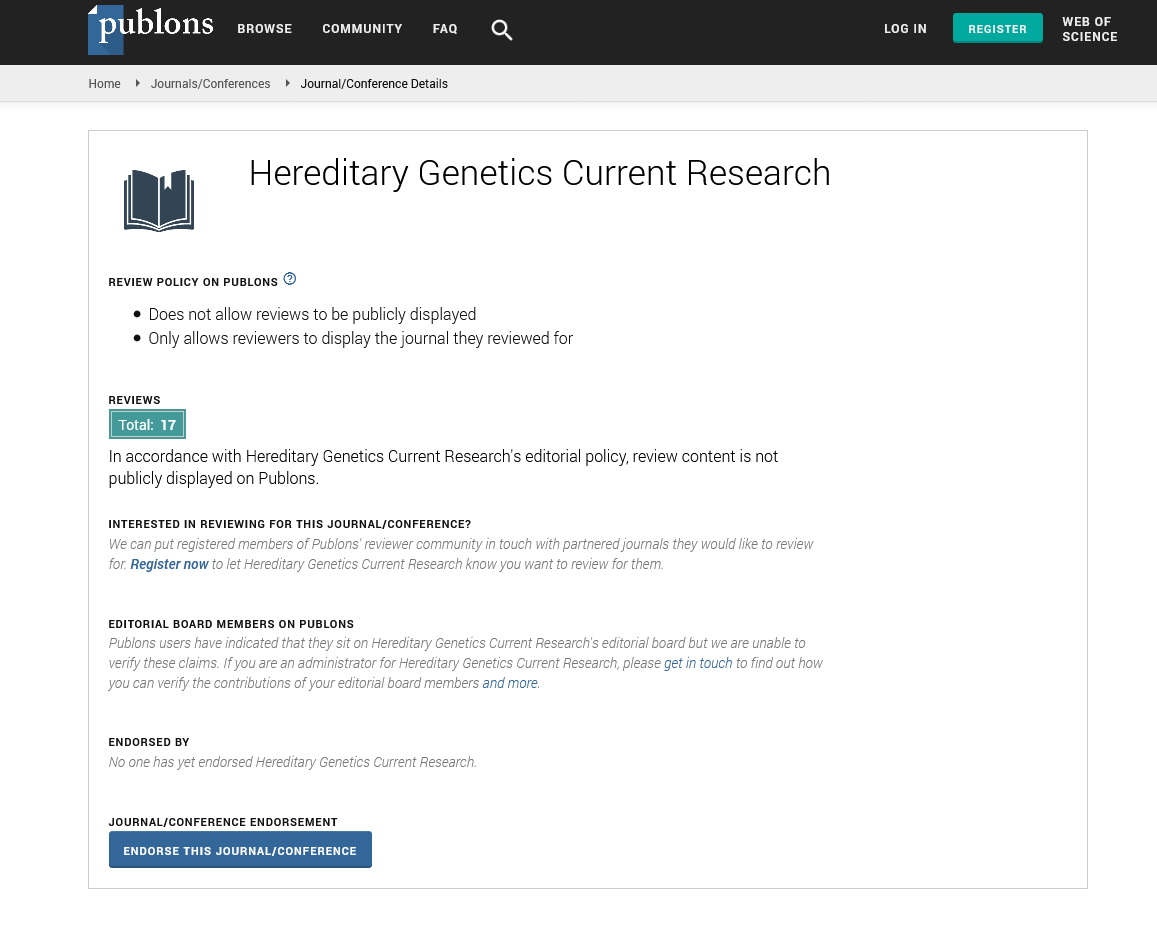Indexed In
- Open J Gate
- Genamics JournalSeek
- CiteFactor
- RefSeek
- Hamdard University
- EBSCO A-Z
- NSD - Norwegian Centre for Research Data
- OCLC- WorldCat
- Publons
- Geneva Foundation for Medical Education and Research
- Euro Pub
- Google Scholar
Useful Links
Share This Page
Journal Flyer

Open Access Journals
- Agri and Aquaculture
- Biochemistry
- Bioinformatics & Systems Biology
- Business & Management
- Chemistry
- Clinical Sciences
- Engineering
- Food & Nutrition
- General Science
- Genetics & Molecular Biology
- Immunology & Microbiology
- Medical Sciences
- Neuroscience & Psychology
- Nursing & Health Care
- Pharmaceutical Sciences
Commentary Article - (2024) Volume 13, Issue 2
Commentary on Preimplantation Development Analysis with Different Chromosomal Abnormalities
Hannah Valantine*Received: 28-May-2024, Manuscript No. HGCR-24-28364; Editor assigned: 31-May-2024, Pre QC No. HGCR-24-28364 (PQ); Reviewed: 14-Jun-2024, QC No. QC HGCR-24-28364; Revised: 21-Jun-2024, Manuscript No. HGCR-24-28364 (R); Published: 28-Jun-2024, DOI: 10.35248/2161-1041.24.13.282
Description
Preimplantation Development Analysis (PDA) has revolutionized the field of reproductive medicine, allowing clinicians and researchers to better understand the intricate processes that occur during early embryonic development. This approach has become an indispensable tool, particularly in the context of Assisted Reproductive Technologies (ART) like In Vitro Fertilization (IVF). One of the most significant areas where PDA has made an impact is in the detection and analysis of chromosomal abnormalities during preimplantation stages. These abnormalities are often a key factor in failed pregnancies, recurrent miscarriages and congenital disorders. Understanding these issues is essential, not only for improving the outcomes of ART but also for enhancing our general knowledge of human genetics and embryology.
Numerical abnormalities occur when there are either more or fewer chromosomes than the typical 46. The most common example of a numerical abnormality is Down syndrome (Trisomy 21), where an extra copy of chromosome 21 is present. Other numerical anomalies, like trisomy 13 (Patau syndrome) and trisomy 18 (Edwards syndrome), result in severe developmental issues and are often fatal shortly after birth.
Structural abnormalities, on the other hand, involve the rearrangement of chromosome segments. These can include deletions, duplications, inversions, or translocations and they often disrupt normal development. Such structural defects can result in developmental delays, physical deformities, or intellectual disabilities, depending on the specific chromosomes affected.
PGD is performed on blastomeres or trophectoderm cells obtained from embryos at the cleavage or blastocyst stages. This method involves the use of techniques like Fluorescence In Situ Hybridization (FISH), Comparative Genomic Hybridization (CGH) and Next-Generation Sequencing (NGS) to examine the genetic makeup of the embryo. The main aim is to detect any abnormalities in chromosome number or structure before embryo transfer.
Structural chromosomal abnormalities can also have devastating effects, although the consequences may vary depending on the specific structural change. Translocations, for instance, can cause unbalanced distributions of genetic material in the embryo, potentially leading to developmental defects or birth defects. While balanced translocations may not cause obvious problems in the carrier, they can result in unbalanced offspring when the genetic material is distributed unevenly during cell division.
Another important factor is mosaicism, a condition in which different cells within the same embryo carry different chromosomal compositions. Mosaic embryos may show partial development of abnormal cells, leading to both normal and abnormal outcomes in different parts of the body. Mosaicism complicates preimplantation analysis because it can result in embryos that appear normal in some cells but abnormal in others. This phenomenon makes the interpretation of PDA results more challenging, as the likelihood of detecting chromosomal abnormalities can vary between cells.
While the advances in PDA offer clear benefits in terms of selecting embryos with a higher chance of developing normally, these techniques also raise several ethical and psychological questions. The ability to select embryos based on genetic health can lead to difficult decisions for prospective parents, particularly when faced with embryos that may have a genetic abnormality but still have the potential for a successful pregnancy. Additionally, there is concern about the psychological impact on parents who may be informed of abnormal findings, especially when no clear consensus exists on whether an embryo with a mild chromosomal abnormality can result in a healthy child.
The potential for embryo selection also invites broader ethical debates regarding “designer babies” and the societal implications of genetic engineering. While PDA can certainly help to avoid genetic disorders, the notion of selecting embryos based on traits beyond health-such as intelligence or physical appearanceremains a highly contentious issue.
Conclusion
Preimplantation development analysis has made incredible strides in the detection and analysis of chromosomal abnormalities, offering valuable insights into embryonic health and significantly improving ART outcomes. With advances in genetic technologies, we are now able to identify a wider array of chromosomal issues, from numerical anomalies like trisomy’s to subtler structural rearrangements. As these technologies evolve, so too do the ethical and psychological challenges that come with making decisions about embryo selection. However, despite the challenges, PDA holds great promise in reducing the burden of genetic diseases and improving the chances of healthy pregnancies, offering hope for many families seeking to have children.
Citation: Valantine H (2024). Preimplantation Development Analysis with Different Chromosomal Abnormalities. Hereditary Genet. 13:282.
Copyright: © 2024 Valantine H. This is an open accessarticle distributed under the terms of the Creative Commons Attribution License, which permits unrestricted use, distribution, and reproduction in any medium, provided the original author and source are credited.

